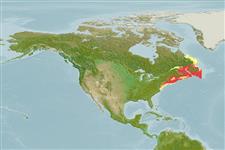>
Perciformes/Cottoidei (Sculpins) >
Agonidae (Poachers) > Hemitripterinae
Etymology: Hemitripterus: Greek, hemi = half + Greek, tres, tria = three + Greek, pteron = wing, fin (Ref. 45335).
More on author: Gmelin.
Environment: milieu / climate zone / depth range / distribution range
Οικολογία
Θαλασσινό(ά) βενθικό(ς); εύρος βάθους 2 - 180 m. Temperate; ? - 16°C (Ref. 27549); 58°N - 36°N, 76°W - 50°W
Northwest Atlantic: Labrador in Canada to Chesapeake Bay in USA.
Μέγεθος / Βάρος / Age
Maturity: Lm ? range ? - ? cm
Max length : 68.0 cm TL αρσενικό/απροσδιόριστο; (Ref. 49746); μεγ. δημοσιευμένο βάρος: 3.2 kg (Ref. 7251)
Inhabit rocky or hard bottom and is a voracious eater. Food includes crustaceans, mollusks, sea urchins, fishes such as herring, sand lance and silver hake, and any bottom invertebrates that are available. When taken out of the water the belly becomes inflated so that when returned to the water they are unable to submerge. Adults attach their eggs near the base of a sponge to use as a spawning bed (Ref. 34819, 41075).
Life cycle and mating behavior
Maturities | Αναπαραγωγή | Spawnings | Egg(s) | Fecundities | Προνύμφες
Adults attach their eggs near the base of a sponge to use as a spawning bed (Ref. 34819, 41075).
Robins, C.R. and G.C. Ray, 1986. A field guide to Atlantic coast fishes of North America. Houghton Mifflin Company, Boston, U.S.A. 354 p. (Ref. 7251)
IUCN Red List Status (Ref. 130435)
Threat to humans
Harmless
Human uses
δόλωμα: occasionally
Εργαλεία
Special reports
Download XML
Διαδικτυακές πηγές
Estimates based on models
Preferred temperature (Ref.
123201): 0.5 - 10.2, mean 3.8 °C (based on 130 cells).
Phylogenetic diversity index (Ref.
82804): PD
50 = 0.6289 [Uniqueness, from 0.5 = low to 2.0 = high].
Bayesian length-weight: a=0.00501 (0.00197 - 0.01276), b=3.15 (2.93 - 3.37), in cm total length, based on LWR estimates for this (Sub)family-body shape (Ref.
93245).
Τροφικό Επίπεδο (Ref.
69278): 4.5 ±0.5 se; based on diet studies.
Ελαστικότητα (Ref.
120179): Πολύ χαμηλό, ελάχιστος χρόνος για διπλασιασμό πληθυσμού > 14 έτη (Preliminary K or Fecundity.).
Fishing Vulnerability (Ref.
59153): Moderate to high vulnerability (47 of 100).
Nutrients (Ref.
124155): Calcium = 32.1 [17.3, 64.8] mg/100g; Iron = 0.341 [0.174, 0.650] mg/100g; Protein = 17.2 [15.9, 18.5] %; Omega3 = 0.575 [0.254, 1.525] g/100g; Selenium = 17.2 [8.4, 40.8] μg/100g; VitaminA = 24.2 [7.4, 79.7] μg/100g; Zinc = 0.423 [0.300, 0.618] mg/100g (wet weight);
